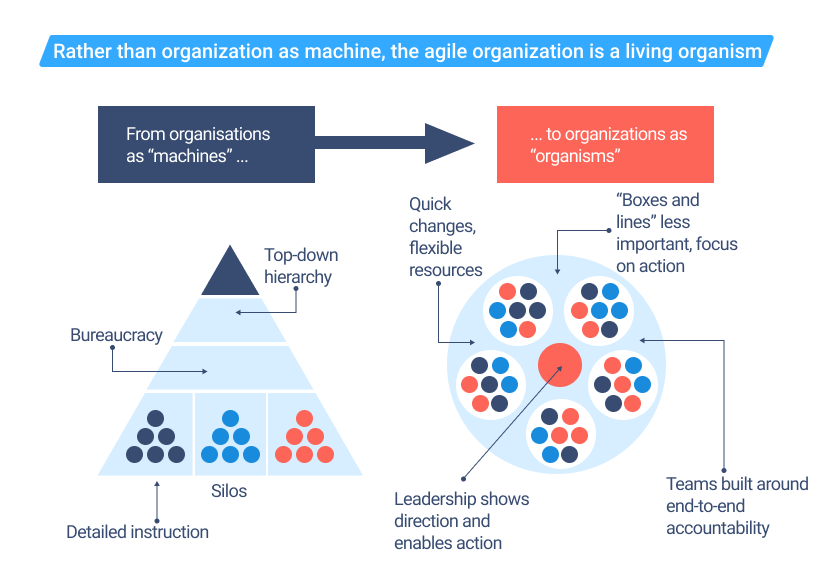
Agile has been growing in recognition since 2001 when this innovative project management approach has been developed and published in the Manifesto for Agile Software Development. The increasing digitalization and the COVID-pandemic highlighted a long-posed question of introducing Agile to companies not on the team level but on the business level.
Enterprise agile transformation is tough, especially for established companies and enterprises. It implies big shifts in workforce attitudes, core company values and mindset. The good news is that it is possible and has been done successfully by many companies. Why and how did they undergo agile transformation? Read on to find out.
What Is Agile Transformation?
Agile transformation is an act of transforming the traditional business model developed primarily for maintaining stability in well-known environments to the agile business model thriving in flexible, collaborative, self-organizing and fast-changing environments.
“Agility is the ability of an organization to renew itself, adapt, change quickly, and succeed in a rapidly changing, ambiguous, turbulent environment.” – Aaron De Smet for McKinsey
Traditional model is based on the idea of an organization as a machine, with a static, siloed, structural hierarchy that operates through linear planning and control. Its structure is strong, but often rigid and slow moving. In contrast, agile organizations are networks of teams that operate in rapid learning and fast decision cycles.

If we break organizational structure into building blocks, we can see the following differences between traditional and agile organizations.
Business agility allows organizations to survive in both solid and unstable circumstances, innovating and delivering effectively in any circumstances. That’s why agile companies and enterprises are believed to be better equipped for the future. Let’s see why agile business model is no longer an option but a necessity.
The Rising Importance of Agility
Before the pandemic happened, many leaders were resistant to introducing business and workplace innovations. For example, the technology allowed us to automate routines and greatly reduced the need in physical offices, though business leaders had been claiming that remote work isn't sustainable… Until the pandemic happened and proved otherwise.
Many business leaders fail to recognize other trends that are transforming industries, economies, and societies, losing the grip of the trends and leaving the competitive advantage to other businesses. Let’s see what trends are most likely to shape our businesses and workplaces in the near future.
- Fast-changing environment that requires a more collaborative model of stakeholder engagement and a more agile approach to business development and competition. Is your enterprise agile enough for that?
- Constant introduction of disruptive technology. Emerging digital and automation tools, innovations require companies to accommodate just to keep afloat. Does your organization welcome the innovations?
- Accelerating digitization. Most information nowadays is digital and online. The pandemic has revealed that remote workplaces work fine as well. The same is true about virtual communication with customers, collaboration inside the teams and across the teams. Do you have a set of collaboration tools and employees trained to use it effectively?
- The emphasis on work-life balance, which includes home offices, hybrid workplaces and flexible schedules. Prior to the pandemic, flexibility was seen as a perk, but nowadays it is a necessity. Are you ready to make the transition?
62% of Google employees want to return to their offices but not every day - CNBC
- The new war for talent. Digitalization and a rapid introduction of innovations require acquiring and retaining talents with a completely different mindset and values (for example, millennials). Your existing workforce also requires training - are you ready to introduce online learning strategies?
- The gig economy continues to rise and its global market size is expected to swell to $455 billion by 2023. Is your company ready to attract and collaborate with freelancers effectively?
Now that you know the business and workplace trends, let’s see how your company can benefit from becoming agile.
Benefits of Agile Transformation
The ultimate goal of agile organizations is to build and maintain such a structure that can quickly and efficiently reconfigure itself in volatile and ambiguous conditions by being agile at all organizational levels, including strategy, structure, processes, people, and technologies. Let’s see what other benefits do agile companies reap.
Customer Satisfaction
Customer satisfaction is one of the highest priorities of agile organizations. Through regular interactions with customers they clarify expectations, tackle issues when they arise and adjust their approaches to meet customers’ standards.
Reduced risks. Step-by-step project development with regular communication, testing and feedback stages keep the chances of failure to the minimum. Agile teams stay in regular contact with customers throughout the development process to clarify expectations, collaborate on fixes, or to further discuss customer needs as they evolve.
Superior product quality. Agile teams develop products in iterations followed by testing. Add constant client involvement to the equation and you’ll get high quality results that completely satisfy the needs of the clients.
Operational Performance
Operational performance includes productive distribution that brings maximum output in the given circumstances. Agile companies achieve it due to flexible structure, management and administration.
Enhanced transparency. Unlike traditional companies, agile organizations share their visions and goals across teams and individuals increasing transparency of leadership and improving accountability across the organization. This transparency helps every employee understand how their work ties into the big picture and why their work matters, which is critical for morale.
Accelerated delivery. Agile companies deliver products faster due to flexible resource allocation, frequent testing, meaning quick problem addressing, less bottlenecks and greater adaptability to change.
Increased adaptability. Adaptability is the main focus and the primal benefit of agile companies. Their culture, structure and management approach allow them to remain competitive even in the most challenging and unstable situations.
Employee Engagement and Satisfaction
The organizational structure and the level of autonomy in agile teams allow employees to enrich their work experience and grow wide and beyond their job duties. Moreover, high employee engagement scores attract better applicants and support organizations in the war for talent.
Increased employee satisfaction. Agile teams provide employees with autonomy that allows them to speed up their professional growth. Employees are motivated to try on new responsibilities, learn new skills and deliver quality work to increase their professional value, while you reap the best of their efforts. These employees will be the most loyal and motivated people in your company.
Better team collaboration. In agile organizations, teams are encouraged to self-organize and offer their own solutions. Every individual takes ownership of their work, meaning they need to solve problems, collaborate and find ways to interact effectively, which is likely to boost team morale.
Enhanced Financial Performance
Financial performance is an inevitable result of 3 previous benefits: customer satisfaction, employee engagement and operational performance. Agile companies show maximum performance in any circumstances while taking into account the needs of their clients and allowing their employees to grow into professionals. Their competitive advantage on the market will attract more clients and generate more revenue than traditional companies.
The need to become agile leaves no doubts, but the question is how do companies make the transition from the traditional model? Enterprises seem impossible to become agile because they are the biggest and the most rigid forms of businesses.
Strategy of Enterprise Agile Transformation
Agile transformation requires a holistic approach to change: your enterprise is required to do Agile and become agile in a step-by-step manner. It will probably take years before your organization can become fully agile, because it requires solid changes in organizational structure and management approaches.
Let’s see what steps do enterprises need to take to become agile.
- Establish a vision. Your enterprise requires agile transformation not because others are going agile but because you want to achieve better results. The examples include generating more revenue, reducing field defects by a certain percentage or generating risk-free value at scale. Define your goal and deliver it to all the stakeholders involved in this transformation.
- Create empowered teams. Through Agile training and coaching, equip your teams with an agile mindset, a set of competencies and techniques. Encourage organic networks across the organization, transfer the ownership of the processes to empowered teams and introduce a culture of continuous improvement.
- Introduce tools and technologies. Enterprise agility requires cross-team communication tools, smart time and project management systems in place, integration solutions that guarantee seamless data exchange, transparency, and immediate recovery in case of a failure.
- Take the first steps. Once your teams are equipped with tools and knowledge, introduce hands-on governance, iterative approach to project delivery, active communication with clients and invest your efforts in building and maintaining this agile structure.
- Accelerate. Once your teams become disciplined and predictable, focus on organizational improvements. Use agile tools to measure quantitative metrics and improve the delivery cycle.
- Adapt. Allow developing agile processes to reshape the enterprise mindset and structure. Let executive leadership and empowered teams respond to the changing demands of the market and clients to achieve gradual and steady progress.
Take the First Step Towards Enterprise Agile Transformation
According to McKinsey, 76% of enterprises consider transforming the culture and ways of working the biggest transformation challenge. To make it smooth, enterprises need to track the changes and adjust to find the right balance.
Try actiTIME - a complex business management solution that provides enterprises with the necessary tools to track and measure individual, team-wide and company-wide efforts.

Online timesheet interface in actiTIME where every user can select task parameters
they want to see in their timesheets
Create custom work scopes, assign work to your teams, track resources and review the trends with real-time widgets and reports. Learn how your enterprise can benefit from actiTIME - start a free 30-day trial to explore the features.


















































